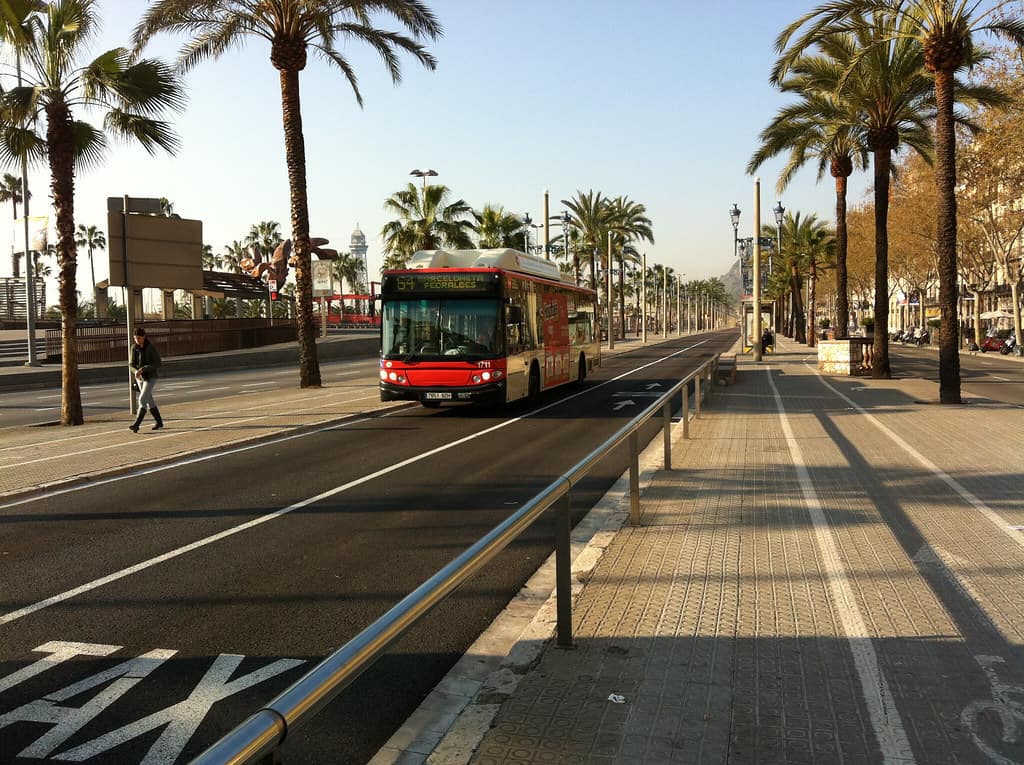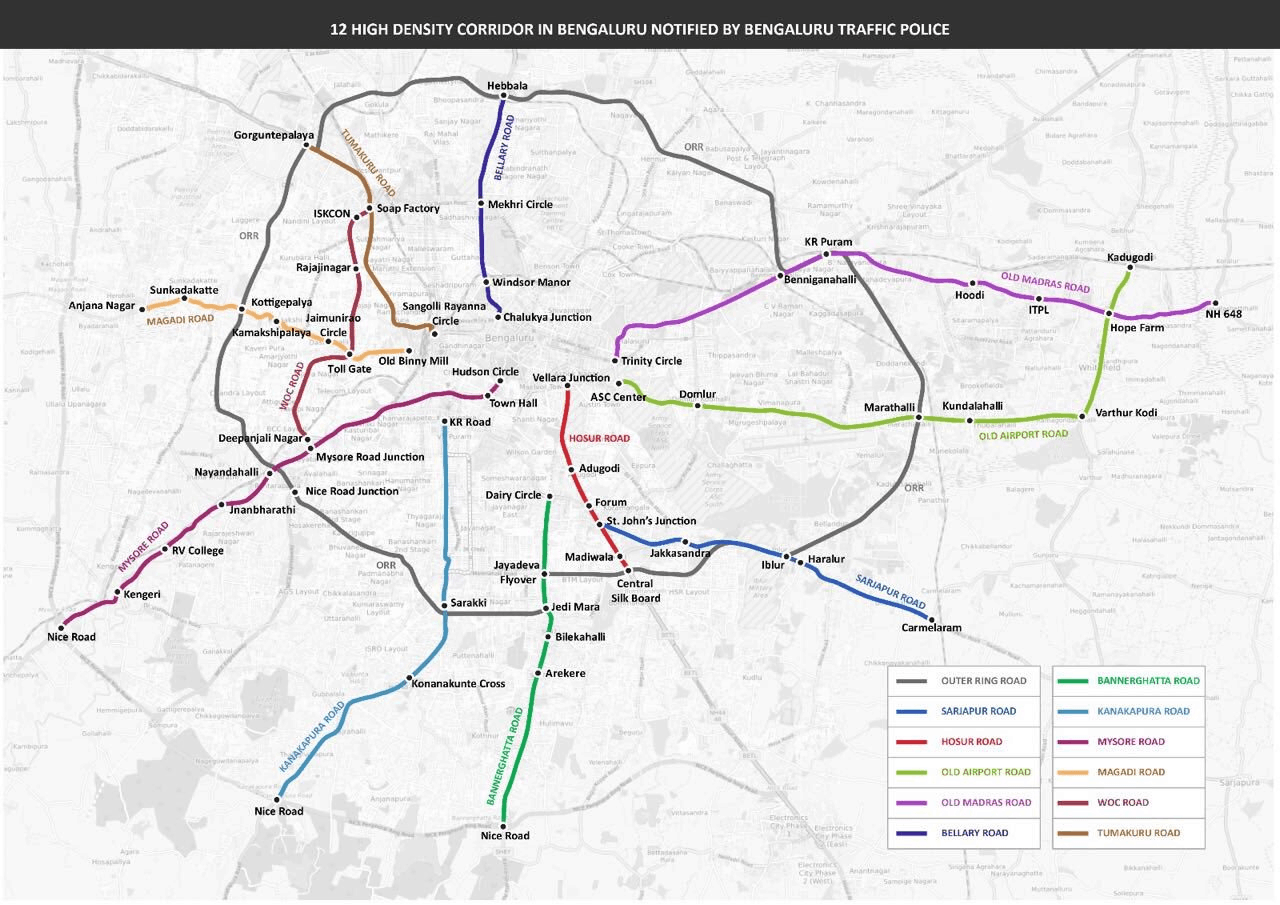The city administration recently resolved to implement bus lanes on the 12 high-density corridors identified by the government in 2016. This brings in some pertinent observations by citizens at large, who are very excited about the project but are also concerned if it would be effective on ground.
What is proposed is not Bus Rapid Transit which is a system with its own dedicated tracks, a separate rolling stock of buses, and separate bus stations (if the ticketing systems are different). The 12 high-density corridors are proposed to have bus priority lanes which use the existing road infrastructure and the same rolling stock as BMTC, but are dedicated lanes to move only buses on priority at signals and junctions.

Bus lanes in Barcelona. Source: Flickr.com
Globally, bus priority lanes are usually just painted, and not necessarily physically segregated. But in the Indian scenario, if not segregated, these lanes tend to attract encroachments by other vehicles and can put an extra load of enforcement on the police.
But bus priority, if designed and implemented properly, will bring about true savings in time for bus commuters and will see the easing of traffic on these corridors. However, some of the concerns that need to be looked into while implementing this project are:
- Placement of bus lanes away from service roads: Especially in corridors like the ORR, there are many roads for property access, with high volume of traffic movement. This can interrupt the priority movement of buses. Hence the corridor needs to be placed away from the service lanes, and towards the carriageway instead.
- Separate signals for bus lane: At junctions, a separate signal should be set up for the bus priority lane. And these signals should be synchronised, so that buses can move continuously across all junctions. Priority lanes alone will not help if the buses get stuck at signals.

At junctions, in addition to the regular signal, a separate signal should be set up for the bus lane. Pic: Wikipedia
- Movable barrier system: If physical segregation is provided to buses, there should be a moveable barrier system for dynamic opening/closing of the bus lane. This would allow opening of the barrier in case a bus breaks down.
- Modernising ticket issue: Often in Bengaluru, several buses are clumped together around major bus stops. One reason for this is the inability of bus conductors to complete the ticket issue for all passengers before they alight at their stop, especially when the bus is crowded. To avoid this, the ticketing system will have to be modernised and technology used – bus passes, ticket kiosks at major bus stops etc are options. Also, a larger route rationalisation plan needs to be arrived at, to avoid clumping of buses.
- Proper intervals between buses: To ensure high efficiency of the bus lanes, proper headways – that is, the average interval between buses on a route – have to be designed. The movement of buses should also be tracked backend using BMTC’s existing GPS system to ensure several buses do not lag due to one slow-moving bus. Using this system, BMTC should be able to delay the dispatch of a bus when required.
- Committee with citizen representatives: The BMTC, BMRCL, Transport department, DULT, BBMP and BTP need to form a co-ordination committee that also has citizen representatives. A project nodal officer can be appointed to convene the committee meetings. Citizen representatives in the committee can guide planners with relevant details from their neighbourhood. They can also help with outreach in their neighbourhood so that both bus users and motorists adopt bus lanes quickly and more effectively, and motorists become aware of how to behave on the road once the lanes are functional. This will ensure that citizens themselves make the plan successful.
- Budget for continued interventions: Budget allocation for the complete network should be committed by the government to ensure this project is not shelved. The budget should allow for continued interventions to promote the use of buses in the corridor, such as signal synchronisation, building better walking and cycling facilities for last-mile connectivity, and so on. It should not be restricted to funding merely the one-time effort to create lanes.
- Planning transport around the corridors: BMTC has to plan for the 12 different ‘pies’ that will be created in between the 12 high-density corridors. ‘Pie’ is a conceptual zone created by crisscrossing of the corridors. Each zone/pie can be treated as a separate bus district having feeder services to various corners in its neighbourhood. That is, they can be treated as smaller units of the city for which separate bus services are run. Thus, each ‘pie’ would act as a hub that feeds the corridors. This ensures that more people use the dedicated bus lanes, and that one corridor is connected to the other.

Source: https://twitter.com/HDCBangalore
- Corridors to be designed as a network: Last but not the least, the administration should have an overall plan that includes the complete network of all 12 corridors, providing various elements such as footpaths, cycle tracks, pedestrian crossings, skywalks if any, signalling, bus stops etc. The corridors should be designed as a network to ensure the continuity and efficiency of bus services at points where the the corridors intersect. This also ensures the continuity of cycle tracks and footpaths, for the safety of cyclists and pedestrians.


Do such well laid out roads really exist in Bangalore city,to think of separate bus lanes and cycle tracks,leave alone pedestrian paths?
All these may look nice in Barcelona (Spain) or Singapore.
Let the motorists first learn and cultivate road sense and traffic sense and the local authorities learn to build and maintain good roads for better commutations.
Buses are a curse within city. Replace buses with double the number of force motors tempo traveller size vehicles, it will reduce traffic jams due to smaller turning radius. buses take 1.5 to 2 lanes of 4 wheelers and stops every where casing Jams.
It may look dumb initially my suggestion, but when more brain is applied will be more fruitful.
Tempo traveller are a curse to bangalore. They are the cause of 95% traffic jams. Opportunistic drivers of these vehicles put on disco lights, jump all signals with blaring music. Dam them from our roads
BBMP stands for Bruhath Brashtachar Mahanagara Palike. Vidhana Soudha is Vedhana Soudha and Nidhana Soudha.
RMP 2031 and CDP has not seen the light of the day. Construction activity has come to a total halt thanks to the CM sitting on files seeking CLU clearance.
Government work is God’s work reads the writing in Secretariat. But it has become Government work is Loot fast and loot soon motto.
Absolutely true as said by S Bhardwaj. Let’s hope when the concerned authorities will take action to repair the roads so as to commute better. Likewise commuters also to cultivate better sense.
Bus drivers need education for Road discipline, Lane discipline. Stop side by side parking in the city, roads have white line border which is never understood by citizens why it is, they just park vehicle’s there. Police, Traffic Police, BMTC and Citizen should form a team to educate parking systems and take action on unethical parking even though person is sitting in the vehicle. Just take videos and seiz the vehicle for one week with fine of towing the vehicle to the seizure vehicles yard outside city limits and take the delivery of the vehicle from the yard directly which will make them follow rules with discipline, NO MERCY FOR VIP, VVIP or Government vehicles.
Our current design system for a in city bus transportation system needs a revamp. Creating a separate bus lane is not going resolve a traffic congestion problem in the Bangalore. One of the main issue we see on bus operating routes is lack proper infrastructure for each and every bus stop. When ever a bus stops at any particular bus stop point, it blocks the moving traffic minimum 20% to 45%. BMTC needs to revisit the layout plan at each and every bus point. The way metro is acquiring to build stations, BMTC needs to collaborate with metro stations to design bus station. One great example here it would be Swami Vivekananda metro station and bus stop point, here bus point is separated from the main road. This design structure need to be replicated everywhere. Bus point at byappanahalli metro station is very badly designed, they have created a separate narrow lane for bus point. If any bus stop at that narrow junction, buses which are behind the first bus, end up stopping the bus in the main traffic moving road. Their is a lot of empty space at this metro station to build a proper bus point, however that space has been ignored completely. This is the first and foremost transformation needed. Here the primary metric to measure is, zero percent age blocking of moving traffic at each and every bus stop.
Secondly, BMTC reports every quarter losses in operating profit. Bangalore is considered to be Silicon Valley for India, still we are not using latest technoliges like IOT to make BMTC operations profitable. A simple IOT design soultion will help BMTC turn from Red to Green on profit status. Each and every bus point should have a IOT enabled box, which has list of all drop location points. All commuters at the bus point are required to press the location they needs to travel. With this design structure BMTC will know the footfall at every sec, this would be dynamic in nature. With this design BMTC can manage their fleet more efficiently, There won’t be any empty buses or overcrowded buses on the road.
1) Restrict entry of long route private buses inside the city during peak traffic time. Entry to these buses shouldn’t be allowed after 6 AM until 11 PM. Some of these buses are parked on the ORR near Marathahalli blocking the entire lane, obstructing the vehicle movement and making the situation worse. One-third of the available road is blocked by these buses near one of the most busy intersection.
2) Restrict movement of heavy vehicles like – construction trucks, lorries, cranes, trucks etc and slow vehicles like tractors during the peak traffic hours specially the office timings – (7 AM to 11 AM and 4 PM to 9 PM).
3) Surveillance of traffic jams using drone cameras:
Drone cameras can be integrated with google maps to identify the spots of traffic jams. Using the drone cameras – identify the vehicle obstructing traffic and fine them heavily. If such vehicle repeats the violence of obstructing the traffic, registration of such vehicles should be temporarily suspended and heavy fines imposed.
The drone cameras can also help in identify break-down vehicles and ensuring timely towing of such vehicles.
4) Promoting use of bicycles for office commute:
This is environment friendly as well as good for health considering the current eating habits and life style.
Reason people don’t use bicycles – safety on road and lack of dedicated bicycle lanes in the city.So if there is dedicated lane for bicycle, the travel time to office would be minimized and safety wont be at risk.
Advantages of using bicycle for office commute:
i)If I go by car, I take and hour to reach office and if I go by bicycle, I would take half an hour to reach office. So I am saving time using bicycle.
ii) I would save on fuel cost.
Two most important resources – time and money are saved.
SO I think dedicated lane for bicycle would promote people taking bicycle not car for office commute.